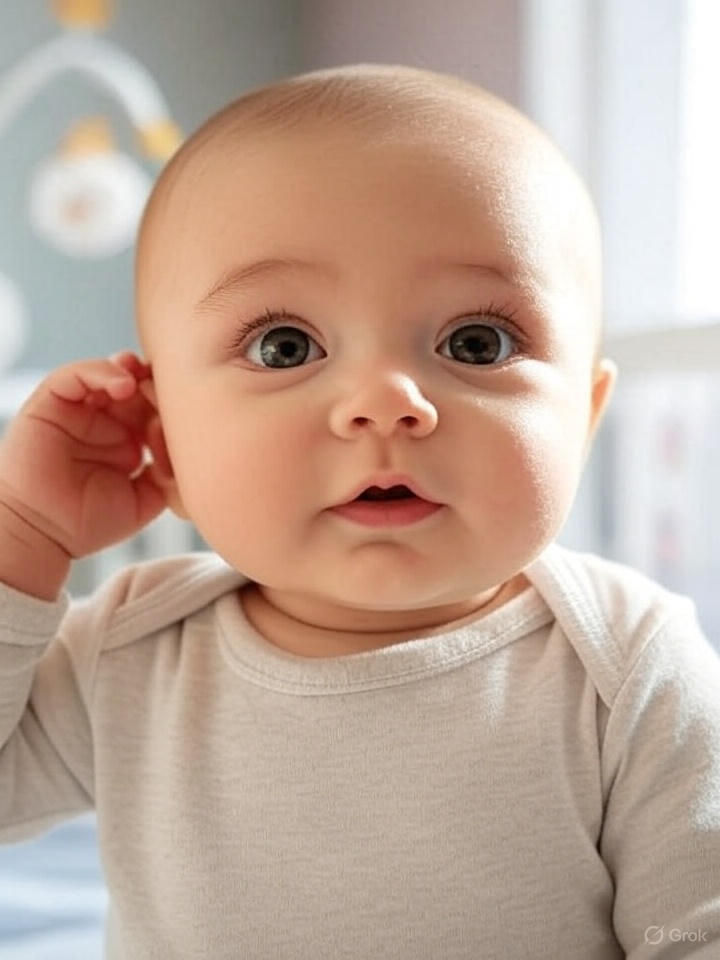Last Updated: August 2025 | Medically Reviewed Content
As a parent, watching your baby constantly rub, tug, or pull at their ears can be both puzzling and concerning. This seemingly innocent behavior often sends parents into a spiral of worry, wondering if their little one is experiencing pain, discomfort, or developing an ear infection. The truth is, ear rubbing in babies is incredibly common and can stem from various causes – some completely harmless, others requiring medical attention.
Understanding why babies engage in this behavior is crucial for every parent’s peace of mind and their child’s wellbeing. This comprehensive guide will explore the multitude of reasons behind ear rubbing, help you distinguish between normal exploration and potential health concerns, and provide practical strategies for managing this behavior effectively.
Understanding Normal Baby Development and Self-Soothing Behaviors

Before diving into specific causes, it’s essential to understand that babies are naturally curious explorers. According to developmental psychology research, infants begin discovering their bodies around 2-3 months of age, and ear touching is often part of this normal exploration process.
The American Academy of Pediatrics emphasizes that self-soothing behaviors, including ear rubbing, are completely normal developmental milestones. Babies don’t yet have the cognitive ability to understand cause and effect, so they engage in repetitive behaviors that provide comfort or sensory satisfaction.
The Science Behind Self-Soothing
When babies rub their ears, they’re often engaging in what child development experts call “self-soothing behavior.” This action releases endorphins – the body’s natural “feel-good” chemicals – which help babies regulate their emotions and manage stress. Just as adults might massage their temples when tired or stressed, babies instinctively find ways to comfort themselves.
Research published in developmental pediatrics journals shows that repetitive motions like ear rubbing can actually help babies:
- Regulate their nervous system
- Transition between sleep states
- Cope with overstimulation
- Provide sensory input that feels pleasant
Primary Reasons Why Babies Rub Their Ears
1. Normal Exploration and Discovery
Age Range: 2-6 months
The most common reason for ear rubbing in healthy babies is simple curiosity. During the first few months of life, babies are constantly discovering new parts of their bodies. Their ears, being easily accessible and providing interesting textures and sensations, naturally become objects of fascination.
Signs this is normal exploration:
- Baby seems happy and content while touching ears
- Behavior occurs during alert, playful periods
- No signs of distress or crying
- Baby explores other body parts similarly
- No fever or other symptoms present
2. Fatigue and Sleep Signals

Age Range: All ages, most common 3-12 months
Many babies develop ear rubbing as a sleep cue or fatigue signal. Similar to how some children suck their thumbs or rub a blanket, ear touching becomes a comforting ritual that helps them prepare for sleep.
According to pediatric sleep specialists, this behavior often develops because:
- The repetitive motion is soothing
- It becomes associated with the transition to sleep
- The soft earlobe provides tactile comfort
- It helps babies self-regulate when overtired
Identifying fatigue-related ear rubbing:
- Occurs primarily when baby is tired
- Accompanied by yawning, eye rubbing, or fussiness
- Happens around regular nap times or bedtime
- Baby may fall asleep while rubbing ears
- Decreases when baby is well-rested
3. Teething Discomfort
Age Range: 4-24 months (peak at 6-12 months)
Teething can cause referred pain that babies feel in their ears due to shared nerve pathways. The trigeminal nerve, which affects both the jaw and ear area, can make teething pain feel like it’s coming from the ears.
Teething-related ear rubbing signs:
- Increased drooling
- Desire to chew on everything
- Slightly elevated temperature (under 101°F)
- Irritability, especially during feeding
- Red, swollen, or tender gums
- Changes in eating or sleeping patterns
The Mayo Clinic notes that this type of discomfort is temporary and typically resolves as each tooth emerges.
4. Ear Infections (Otitis Media)
Age Range: 6 months – 3 years (peak occurrence)
Ear infections are among the most common childhood illnesses, affecting up to 80% of children by age three, according to the National Institute on Deafness and Other Communication Disorders.
Red flag symptoms requiring medical attention:
- Persistent crying or obvious pain
- Fever above 101°F (38.3°C)
- Difficulty sleeping or eating
- Unusual irritability
- Yellow, green, or bloody discharge from ear
- Hearing difficulties or lack of response to sounds
- Tugging at ears combined with other illness symptoms
Important Note: If you suspect an ear infection, consult your pediatrician promptly. Untreated ear infections can lead to complications.
5. Earwax Buildup
Age Range: Any age, more common after 6 months
Excessive earwax can cause discomfort, leading babies to rub or scratch at their ears. While some wax is normal and protective, too much can cause irritation.
Signs of problematic earwax:
- Visible wax buildup in the ear canal
- Temporary hearing changes
- Mild discomfort without other symptoms
- Scratching specifically at the ear opening
Important: Never attempt to remove earwax with cotton swabs or other objects. This can push wax deeper or damage the ear canal.
6. Skin Conditions and Allergies
Age Range: Any age
Various skin conditions can affect the ear area, causing itching and subsequent rubbing:
- Eczema: Creates dry, itchy patches that may extend to ears
- Contact dermatitis: Reaction to soaps, lotions, or fabrics
- Food allergies: Can manifest as skin irritation
- Cradle cap: May extend to ear area in young infants
7. Environmental Factors
External factors can contribute to ear discomfort:
- Dry air: Can cause skin irritation
- Cold weather: May make ears feel uncomfortable
- Hair products: Residue can irritate sensitive ear skin
- Clothing: Rough fabrics or tight hats might cause irritation
When to Worry: Red Flag Symptoms
While ear rubbing is usually harmless, certain symptoms warrant immediate medical attention:
Immediate Medical Care Needed:
- High fever (over 101°F/38.3°C)
- Severe, persistent crying suggesting pain
- Discharge from the ear (especially if bloody or foul-smelling)
- Signs of hearing loss
- Balance problems or dizziness
- Swelling around the ear
Schedule a Pediatric Appointment:
- Ear rubbing combined with cold symptoms lasting over a week
- Changes in eating or sleeping patterns
- Unusual irritability persisting for several days
- Any concerns about your baby’s behavior or development
Age-Specific Considerations
Newborns (0-2 months)
- Ear touching at this age is usually accidental
- Focus on ruling out discomfort from positioning or clothing
- Monitor for signs of infection, though rare at this age
Infants (2-6 months)
- Peak time for exploration-based ear touching
- Establish whether behavior is related to fatigue or discovery
- Beginning of potential teething symptoms
Older Babies (6-12 months)
- Increased risk of ear infections due to anatomy and increased exposure to germs
- Teething becomes a more common cause
- Self-soothing behaviors become more established
Toddlers (12+ months)
- May be able to communicate discomfort verbally
- Behavior patterns are more established
- Environmental factors become more relevant
Effective Management Strategies
For Normal Exploration:
- Provide alternatives: Offer textured toys or safe objects for exploration
- Keep nails trimmed: Prevent accidental scratching
- Maintain cleanliness: Gently clean ears during bath time
- Monitor without intervention: Allow normal exploration to continue
For Sleep-Related Rubbing:
- Establish consistent routines: Help baby recognize sleep cues
- Create comfortable environment: Appropriate temperature and lighting
- Offer comfort objects: Soft blankets or approved loveys
- Monitor sleep quality: Ensure adequate rest to prevent overtiredness
For Teething Discomfort:
- Provide appropriate teethers: Cold or textured options
- Gentle massage: Rub gums with clean finger
- Cold foods: For babies eating solids, offer cold fruit
- Consult pediatrician: About appropriate pain relief options
For parents looking to maintain their energy during these challenging phases, ensuring proper nutrition is crucial. Consider reading about healthy snacking options to support your wellbeing while caring for your little one.
Prevention Strategies
Hygiene Practices:
- Keep baby’s hands and nails clean and trimmed
- Gently clean ears with washcloth during bath time
- Use mild, fragrance-free products around ear area
- Ensure proper drying after baths
Environmental Modifications:
- Maintain appropriate humidity levels in nursery
- Use gentle, hypoallergenic fabrics
- Avoid harsh chemicals or strong fragrances
- Keep baby’s environment clean but not sterile
Health Monitoring:
- Track patterns in ear rubbing behavior
- Note accompanying symptoms
- Maintain regular pediatric checkups
- Stay current with vaccinations
Home Remedies and Comfort Measures
Safe Home Interventions:
For general discomfort:
- Warm compress applied to outside of ear (never inside)
- Gentle distraction with engaging activities
- Comfortable positioning during feeding and sleep
- Ensuring adequate hydration and nutrition
For dry skin:
- Fragrance-free moisturizer applied to outer ear area
- Humidifier in baby’s room
- Gentle, natural skincare products
For teething-related discomfort:
- Cold washcloth for baby to gnaw
- Refrigerated (not frozen) teething toys
- Gentle gum massage
- Appropriate over-the-counter pain relief as directed by pediatrician
What NOT to Do:
- Never insert anything into baby’s ear canal
- Avoid using cotton swabs inside ears
- Don’t apply oils or liquids inside ears without medical advice
- Never ignore persistent symptoms hoping they’ll resolve
- Avoid using adult medications or remedies
Professional Medical Interventions
When Pediatric Care is Necessary
Your pediatrician may recommend various interventions based on the underlying cause:
For ear infections:
- Antibiotic treatment (if bacterial)
- Pain management strategies
- Follow-up care to ensure resolution
- Prevention strategies for recurrent infections
For chronic issues:
- Referral to pediatric ENT specialist
- Hearing tests if indicated
- Allergy testing if suspected
- Specialized treatment plans
Diagnostic Procedures
Modern pediatric medicine offers several diagnostic tools:
- Otoscopy: Visual examination of ear canal and eardrum
- Tympanometry: Tests eardrum movement and pressure
- Hearing screenings: Assess auditory function
- Allergy testing: If environmental triggers suspected
Creating a Supportive Environment
Family Strategies
Communication with caregivers:
- Document patterns and triggers
- Share observations with daycare providers
- Maintain consistent approaches across caregivers
- Regular check-ins about behavior changes
Managing parental stress: During challenging periods of frequent ear rubbing or potential health concerns, parents need support too. Maintaining perspective and finding moments of peace can be crucial. Consider exploring spiritual resources that might provide comfort during stressful parenting moments.
Building support networks:
- Connect with other parents experiencing similar challenges
- Utilize online parenting communities responsibly
- Maintain open communication with healthcare providers
- Don’t hesitate to seek help when overwhelmed
Long-term Developmental Considerations
Normal Development Expectations
Most babies who rub their ears as infants develop completely normally. According to longitudinal studies published in developmental pediatrics, self-soothing behaviors typically evolve or diminish as children develop other coping mechanisms and communication skills.
Typical progression:
- 0-6 months: Exploration and discovery phase
- 6-18 months: Peak period for various causes (teething, infections)
- 18+ months: Gradual decrease as communication improves
- 2-3 years: Most children have developed alternative comfort strategies
When Behaviors Persist
In rare cases, persistent ear rubbing beyond typical developmental windows might indicate:
- Chronic medical conditions requiring ongoing management
- Sensory processing differences needing specialized support
- Behavioral patterns requiring gentle redirection
Frequently Asked Questions
Q: Is it normal for my 3-month-old to rub ears daily?
A: Yes, if your baby seems content and shows no signs of distress, daily ear touching is typically normal exploration behavior. Monitor for any changes in intensity or accompanying symptoms.
Q: How can I tell the difference between teething and ear infection?
A: Teething usually involves increased drooling, desire to chew, and mild temperature elevation. Ear infections typically cause more severe pain, higher fever, and may include discharge. When in doubt, consult your pediatrician.
Q: Should I stop my baby from rubbing their ears?
A: Unless there are signs of injury or underlying medical issues, gentle ear rubbing doesn’t need to be stopped. Focus on ensuring safety (trimmed nails) and monitoring for concerning symptoms.
Q: Can ear rubbing cause damage?
A: Gentle rubbing typically won’t cause harm. However, vigorous scratching or insertion of objects can cause injury. Keep nails short and provide safe alternatives for exploration.
Q: When do babies typically outgrow ear rubbing?
A: Most children naturally reduce ear rubbing behaviors as they develop other self-soothing strategies and communication skills, typically by age 2-3 years.
Expert Insights and Research
Recent pediatric research emphasizes the importance of understanding infant behavior within the context of normal development. The American Academy of Pediatrics guidelines stress that most repetitive behaviors in infants are part of healthy neurological development.
Studies published in prominent medical journals, including those indexed in PubMed, consistently show that early intervention and proper assessment of infant behaviors lead to better outcomes and reduced parental anxiety.
Leading pediatric specialists recommend a balanced approach: remaining observant without becoming overly anxious, seeking professional guidance when warranted, and trusting parental instincts when something seems genuinely concerning.
Conclusion: Embracing Understanding and Confidence
Understanding why babies rub their ears empowers parents to respond appropriately to their child’s needs while maintaining peace of mind. Remember that this behavior, while sometimes concerning, is usually a normal part of infant development and exploration.
The key to managing ear rubbing effectively lies in careful observation, understanding your individual child’s patterns, and knowing when to seek professional guidance. Most babies who engage in ear rubbing are simply exploring their world, seeking comfort, or communicating needs in the only way they know how.
By staying informed, maintaining open communication with healthcare providers, and trusting your parental instincts, you can navigate this common childhood behavior with confidence. Remember that every baby is unique, and what works for one child may not work for another.
As your baby grows and develops better communication skills, many of these early behaviors will naturally evolve or disappear entirely. In the meantime, focus on providing a safe, loving environment where your little one can explore and develop at their own pace.
The journey of parenthood is filled with questions and concerns, but with knowledge, support, and professional guidance when needed, you’re well-equipped to help your baby thrive through every developmental stage.
This article is for informational purposes only and should not replace professional medical advice. Always consult with your pediatrician regarding specific concerns about your baby’s health and development.
Sources and Further Reading:
- American Academy of Pediatrics Clinical Guidelines
- National Institute on Deafness and Other Communication Disorders
- Pediatric Development Research Archives
- Mayo Clinic Pediatric Resources
- PubMed Database of Medical Literature





Pingback: Which Babies Are Kept in NICU: A Complete Guide for Parents - Snapspeak